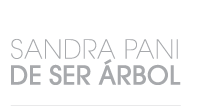Last Call: Sandra Pani at Newcomb Art Gallery
By Emily Wilkerson
It’s the last weekend to catch Sandra Pani's "De ser árbol" at Newcomb Art Gallery. Before it's gone, Emily Wilkerson reviews. Suspended from the tall ceilings of the Newcomb Art Gallery, Mexican artist Sandra Pani’s drawings sway as air flows among them. The 36 graphite works on paper, measuring approximately 10-by-3.5 feet each, are displayed in pairs back to back. Forming a maze, the works in “De ser árbol (Of Being a Tree)" obstruct one’s views across the gallery. They demand the visitor look up and around, contemplating his or her presence in the space as music by collaborating composer Mario Lavista hums in the background.
Using her body to create imprints then expanding upon them in graphite, Pani constructs abstract works that physically and conceptually navigate the connections between nature and the human body. Here she examines specifically our affinity to trees, intentionally blurring the boundaries of form, and in turn highlighting our similarities. In Axis mundi II, 2007, a thin line crawls up the middle of the paper while pencil markings and fingertip smudges form a central constellation—the title of the work and its visualization forming a precise paradigm for the series.
If we imagine Axis mundi II as a potential starting point, we see textures and gradations build throughout the series. Branches begin to sprout and the human figure and authorial hand become more apparent. Such is the case with Mi tórax seis veces (My Chest Six Times), 2009, in which Pani constructs a central column out of successive imprints of her chest. One atop the other, Pani emphasizes the rib cage, the spine, and the veins that reach beyond the core, all fixed to the bottom of the paper through a drawn system of roots. In Cuerpo árbol crucifixión descendimiento (Body, Tree, Crucifixion, Descent), 2007, not only does Pani layer the graphite to form a dark, towering frame of a human figure, but she also leaves a smeared handprint visible in the bottom right corner of the work, drawing attention to both process and scale.
Among named influences such as Francis Bacon and Louise Bourgeois, Pani’s series exists within a network of twentieth-century avant-garde practices rooted in conceptual and performance art. The use of the body as a tool in these practices, and its relation to the work’s afterlife, raises questions about the artist’s relationship to both art making and to his or her presence within a specific society and the world. Pani’s technique finds corollaries in the work of David Hammons, Ana Mendieta, and Kazuo Shiraga, who each responded to complex questions of identity using their bodies, ultimately enacting different meanings for both spectator and artist. The specific role of Pani’s body in her work foregrounds her conviction that “the universal essence becomes visible through forms of nature, the expressions of the psyche and the similarities between them.” If the gesture is not religious, it is nevertheless spiritual—an act of devotion. The physical interaction of body on paper, the opposing acts of drawing and erasing on paper, and even the language ultimately assigned to the paper ritually express Pani’s understanding of the cyclical processes of life—the returning to foundations and thus toward renewal.
"De ser árbol" on view through March 3 at Newcomb Art Gallery, Woldenberg Art Center, Tulane University.
Last Call: "Reflections Through a Lens" at HomeSpace
It’s the last weekend to catch “Reflections Through a Lens: The Genre of Self-Portr ...
By Taylor Murrow




